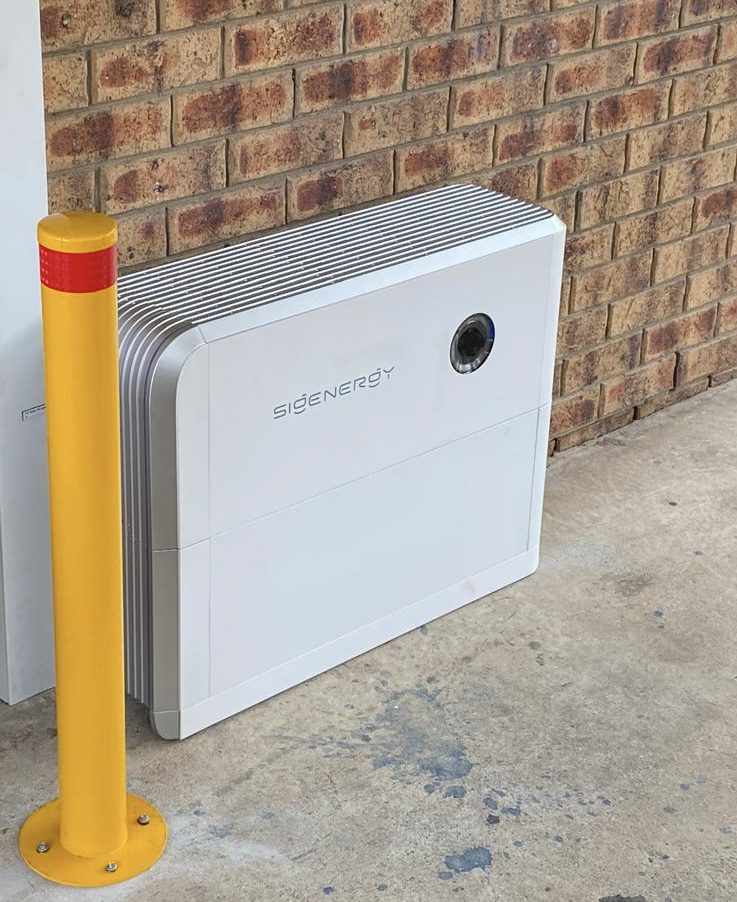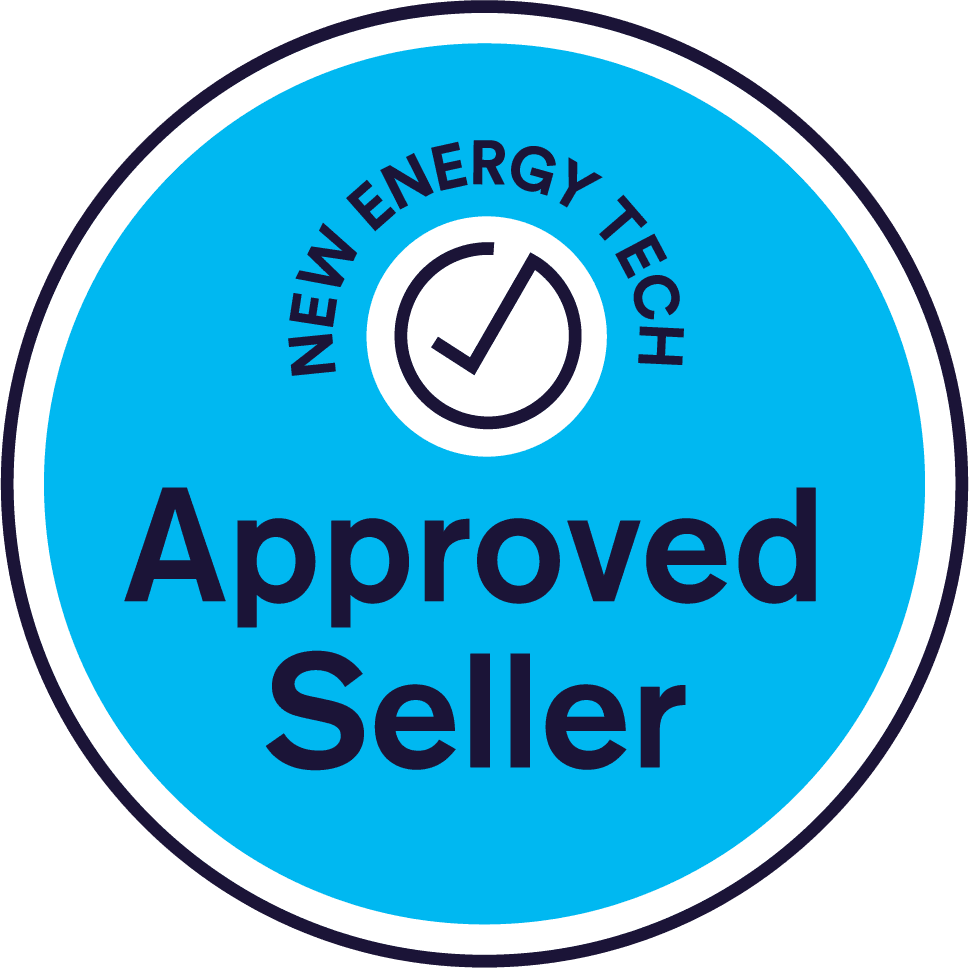Best Solar Battery in 2025: What Australian Homeowners Need to Know
Before we get into the details, it is probably worth mentioning that we do not have an affiliation with any solar battery manufacturers or suppliers. This article gives you our honest opinion of the best solar battery in 2025, in Australia, based on our experience installing thousands of solar batteries. There are lots of other battery brands out there, but we believe these four batteries are the best by quite some distance.
At GI Energy, we’ve been helping Australians save money on power bills since 2011. In an industry where the average company doesn’t make it past its second birthday, we’ve stuck around by putting our customers first — before, during, and long after installation.
And now, with solar battery tech advancing faster than ever, 2025 is the perfect time to consider a home energy storage solution.
If you’ve been Googling “best solar battery 2025”, you’re in the right place. We’ve broken down the top four batteries for Aussie homes — Sigenergy, BYD, Sungrow, and Tesla — to help you find the perfect fit for your household.
What Makes a Battery the “Best” in 2025?
It’s not just about specs on a datasheet. For our customers, the best battery balances:
✅ Lower energy bills
✅ Reliable blackout protection
✅ Long lifespan and warranty
✅ Flexibility to grow with your needs
✅ Future-ready features like EV charging
✅ Seamless integration with your existing (or new) solar
And just as importantly: installation by a team you trust. That’s where we come in.
Sigenergy — The Most Advanced Battery on the Market. The Best Solar Battery in 2025
Overview
Sigenergy is the new tech leader in solar batteries. It’s designed to do it all: home backup, smart monitoring, fast EV charging, and more — all in one sleek stackable system.
Where some brands offer incremental updates, Sigenergy has leapt ahead with innovations that solve real-world problems.
Key Features
| Spec | Sigenergy |
| Capacity per stack | 5–48 kWh |
| Max number of stacks | Multiple (for commercial/home use) |
| Chemistry | LFP (Lithium Iron Phosphate) |
| Efficiency | ~98% DC / 90% Ac Coupled round-trip |
| Safety | 7 sensors per module, AI monitoring, fire suppression |
| Backup | Single and three-phase with blackstart |
| Outdoor rating | IP66 |
| Coupling | AC & DC compatible |
| EV support | DC fast charging + V2H/V2G ready & AC Charging |
| App control | Yes, with visual LED indicators |
What Makes Sigenergy The Best Solar Battery In 2025?
- Unmatched Safety
Each module is packed with 7 internal sensors and monitored via AI. If it detects heat or pressure buildup, the fire suppression system activates — offering peace of mind for families.
- Truly Scalable
Start with 10 kWh or go all the way up to 48 kWh in one stack. And if you outgrow that? Add another stack. It’s the most modular system on the market.
- Designed for Australia
IP66 means this unit is both waterproof and dustproof — ideal for harsh Aussie summers or coastal humidity.
- Smart Visual Display
External LEDs show how full the battery is. You can see at a glance whether you’ve got backup power — even if your phone’s out of reach.
- Blackstart Recovery
Most systems stay “dead” in a long outage if the grid doesn’t come back. Sigenergy can recharge itself from solar even when completely empty — a huge advantage in extended blackouts.
- Electric Vehicle Integration
It’s the only system in this roundup with DC fast charging for EVs. It also supports Vehicle-to-Home (V2H) and Vehicle-to-Grid (V2G) functions — making it perfect for EV owners.
Cost and Warranty
- Estimated Installed Cost: $14,000–$30,000 depending on size
- Warranty: 10 years, includes 70% capacity retention guarantee
Ideal For:
- Homeowners wanting maximum tech & safety
- Those planning to get an EV
- People in areas with frequent blackouts
- Anyone future-proofing their energy setup
For all the reasons above, we are happy to recommend Sigenergy as the best solar battery in 2025.
For a comprehensive video review, click here.
BYD Battery-Box – The 2nd Best Battery In 2025. Rugged Reliability and Commercial-Grade Performance
Overview
BYD (Build Your Dreams) is one of the largest lithium battery manufacturers in the world. They’ve powered everything from public transport fleets to residential homes, and their Battery-Box is known for its dependability, flexibility, and affordability — especially for larger homes and businesses.
This system might not have all the bells and whistles of Sigenergy, but when it comes to performance, longevity, and cost-effectiveness, BYD is hard to beat.
Key Features
| Spec | BYD Battery-Box HVL |
| Modular Capacity | 5 to 66 kWh |
| Max Output | ~11.4 kW (inverter dependent) |
| Chemistry | LFP (Lithium Iron Phosphate) |
| Coupling | DC-coupled only* |
| Backup | Yes (requires hybrid inverter) |
| Weatherproof Rating | IP55 |
| Compatibility | Fronius Gen24 |
| Efficiency | ~96% round-trip |
| Monitoring | Through hybrid inverter interface |
*Technically you can AC couple the BYD and Sungrow SBH battery but the only use case is if you are keeping the existing no-hybrid inverter with an existing solar system and using a hybrid inverter in addition to this. That way, you can AC couple it, but it means you are using two inverters which is not usually a cost effective or efficient design.

Why BYD Makes Sense
- Tough and Scalable
Each stack consists of 4–8 modules, each offering 4 kWh. You can scale from 12 to 96 kWh in a single stack, and even combine stacks for larger applications.
- No-Nonsense Engineering
There’s no flashy screen or app interface here — but that also means less to go wrong. BYD’s focus is solid construction and battery chemistry.
- Proven Track Record
This isn’t just theory — BYD batteries are used worldwide in electric buses, buildings, and heavy machinery, making them among the most field-tested batteries available today.
- Perfect for New Builds
BYD works best in systems that include a new hybrid inverter. This makes it a great choice if you’re starting fresh with a solar + battery install.
Cost and Warranty
- Estimated Installed Cost: From ~$11,000 (for ~16 kWh)
- Warranty: 10 years OR 3000kWhs/kWh throughput (whichever comes first)
What Does the Throughput Warranty Mean?
This means you can use up to 3000kWhs of energy for every 1 kWh of capacity before the warranty is exhausted. For a 16 kWh system, that’s 48,000 kWh of total throughput — easily enough for 10+ years of use.
Pros:
✅ Cost-effective per kWh
✅ Perfect for larger installations
✅ Robust and industrial-grade components
✅ Globally trusted brand
Cons:
❌ No AC-coupling (not ideal for retrofits)
❌ Requires compatible inverter
❌ No integrated app or LED indicators
Ideal For:
- New solar + battery installations
- Homeowners with large energy needs
- Budget-conscious customers who still want top-tier quality
- Anyone who values longevity and proven reliability
We have been installing BYD batteries for many years now and we are happy to recommend them as the second best solar battery in 2025.
Sungrow SBH — Australia’s Best Value-for-Money Solar Battery
Overview
Sungrow is a powerhouse in renewable energy. With over 405 GW deployed globally and operations in 150+ countries, it’s one of the most bankable solar brands in the world. Their SBH battery is the perfect blend of flexibility, affordability, and performance.
If you want excellent energy storage without the high price tag of Tesla or Sigenergy — and still want blackout protection and smart monitoring — Sungrow may be your best bet.
Key Features
| Spec | Sungrow SBH |
| Capacity Range | 9.6 – 102.4 kWh (16 kWh typical for homes) |
| Chemistry | LFP (Lithium Iron Phosphate) |
| Voltage Range | 384V – 512V |
| Coupling | DC only (requires Sungrow hybrid inverter)* |
| Backup Support | Yes, single- and three-phase |
| Protection | IP55 (outdoor rated) |
| Modular Size | 3.2 kWh modules |
| Monitoring | iSolarCloud app |
| Round-trip Efficiency | ~92% |
*Technically you can AC couple the BYD and Sungrow SBH battery but the only use case is if you are keeping the existing no-hybrid inverter with an existing solar system and using a hybrid inverter in addition to this. That way, you can AC couple it, but it means you are using two inverters which is not usually a cost effective or efficient design.

What Makes Sungrow a Standout?
- Low Cost Per kWh
Sungrow delivers some of the lowest cost per usable kilowatt-hour among premium brands — especially when bundled with their own inverters.
- Blackout Backup Included
When paired with a Sungrow hybrid inverter, the SBH can provide full blackout protection, including for three-phase homes — which is rare at this price point.
- Flexibility for Growth
Start with just 9.6 kWh and grow in 3.2 kWh increments. You can scale to over 100 kWh — enough to cover nearly any residential or light commercial need.
- Compact Design, Easy Installation
Each stack of modules is vertically mounted, taking up minimal space. It’s sleek, safe, and straightforward to install with less wiring complexity.
- Built for Aussie Conditions
Its IP55 rating makes it highly resistant to heat, dust, and humidity — great for Australian weather from Brisbane to Perth.
Real-World Example
One GI Energy customer — a small business in regional Queensland — installed a 120 kWh Sungrow system to store excess daytime solar for use overnight. The result? They slashed their reliance on peak grid power and now save thousands each year in electricity bills.
Cost and Warranty
- Estimated Installed Cost: $10,000–$35,000 depending on size
- Warranty: 10 years or 6,000 cycles, whichever comes first
Sungrow backs their battery with one of the most generous warranties in the category, including 70% capacity retention at the end of the term.
Pros:
✅ Amazing value per kWh
✅ Full blackout protection (3-phase capable)
✅ Trusted global brand
✅ Works great with Sungrow inverters
Cons:
❌ Requires Sungrow hybrid inverter
❌ No AC-coupling (less ideal for retrofits)
❌ Monitoring is good, but not as sleek as Tesla’s
Ideal For:
- Homeowners looking for maximum value
- Families with growing energy needs
- Small businesses wanting a cost-effective commercial solution
- People who want future flexibility without overspending

A proven workhorse at a good price – Sungrow – the third best solar battery in 2025.
⭐ Tesla Powerwall 3 — The 4th Best Battery In 2025 Polished Performance from a Global Brand
Overview
Tesla doesn’t just make electric vehicles — they’ve been leading the home battery revolution for years. The Powerwall 3, launched in Australia in late 2024, is the most powerful version yet. It’s sleek, smart, and strong — but it’s also the most expensive option in this roundup.
While it doesn’t offer modularity like others on this list, it still wins points for simplicity, app interface, and high power output.
Key Features
| Spec | Tesla Powerwall 3 |
| Fixed Capacity | 13.5 kWh |
| Max Output | 11.04 kW continuous, 15 kW peak |
| Inverter | Built-in hybrid inverter |
| Chemistry | LFP (Lithium Iron Phosphate) |
| Charge Rate | 5 kW |
| Scalability | Up to 4 units (54 kWh max) |
| Monitoring | Tesla App |
| IP Rating | IP67 (fully waterproof) |
| Coupling | AC & DC |
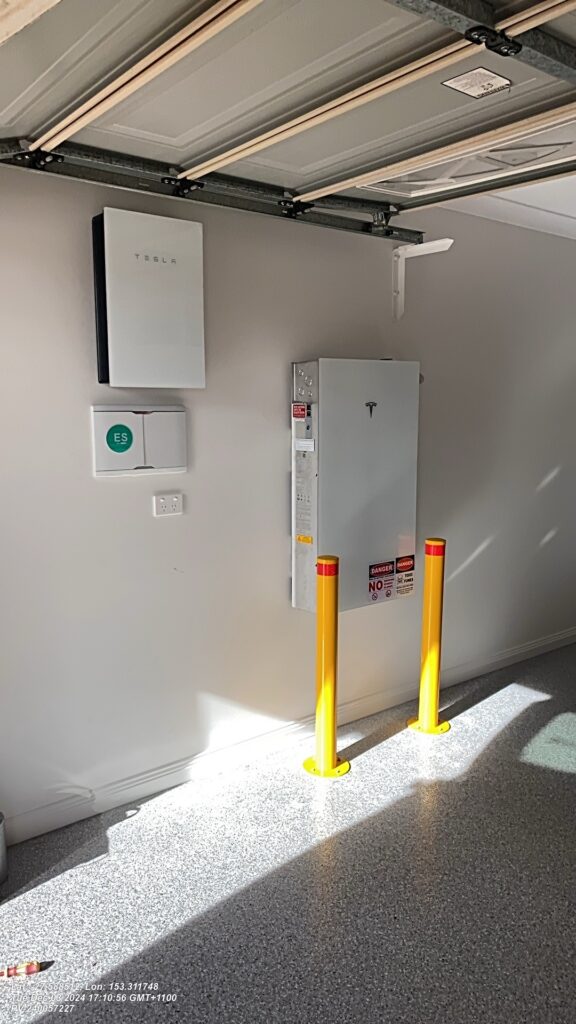
What Stands Out?
- All-in-One Simplicity
Unlike other systems that need separate inverters or external components, Tesla’s Powerwall 3 has an integrated hybrid inverter that can manage both your solar panels and battery. It supports up to 20 kW of solar input and simplifies installation — especially for new builds.
- Super Sleek Design
Let’s face it — Tesla wins the style contest. The Powerwall 3 looks like something out of a sci-fi movie. It’s compact, mounts neatly on the wall, and doesn’t clutter your garage or side yard.
- Top-Tier Mobile App
Tesla’s mobile app is arguably the best in the industry. You can monitor usage, solar generation, battery levels, and grid draw in real-time — from anywhere.
- Strong Output Power
With over 11 kW of continuous output, the Powerwall 3 is ideal for homes with high power demand — such as electric ovens, pool pumps, or ducted air conditioning.
What to Watch Out For
Limited Scalability
While you can stack up to 4 Powerwalls, each is 13.5 kWh — and they aren’t modular like Sigenergy or BYD. That means adding more storage requires buying an entire second (or third) unit, which becomes costly fast.
Slow Charge Rate
Its charge rate is capped at 5 kW, which could limit efficiency for homes with large solar arrays — especially during peak generation hours.
No V2H or V2G (Yet)
Despite Tesla’s EV leadership, the Powerwall 3 doesn’t yet support vehicle-to-home or vehicle-to-grid in Australia.
Compatibility Issues
The Powerwall 3 isn’t backward compatible with the Powerwall 2. If you already have an older model, you’ll need to start a new system from scratch.
Cost and Warranty
- Estimated Installed Cost: $16,000 – $19,000
- Required Backup Gateway: +$1,700
- Warranty: 10 years, 70% capacity guarantee, includes labour
Tesla’s warranty also includes replacement labour ($800 for the battery and $650 for the Gateway), which is rare and adds peace of mind.
Pros:
✅ Sleek design
✅ Strong app interface
✅ High discharge power
✅ Built-in inverter for new systems
Cons:
❌ Most expensive on this list
❌ Not modular — full units only
❌ Limited charge rate (5 kW)
❌ No V2H/V2G support yet
❌ Requires Backup Gateway for blackout protection
Ideal For:
- Homeowners who want a premium brand experience
- Tesla EV owners or those in the Tesla ecosystem
- Households needing high output power for large appliances
- New builds wanting a clean, all-in-one setup
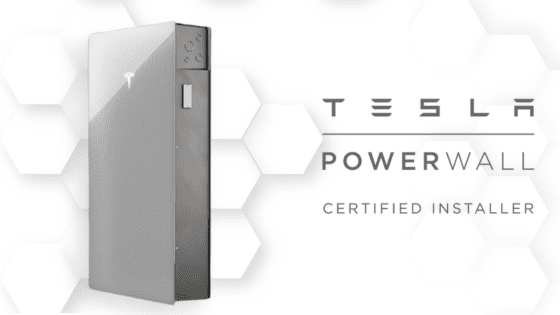
Side-by-Side Comparison Table Of The Best Solar Battery in 2025
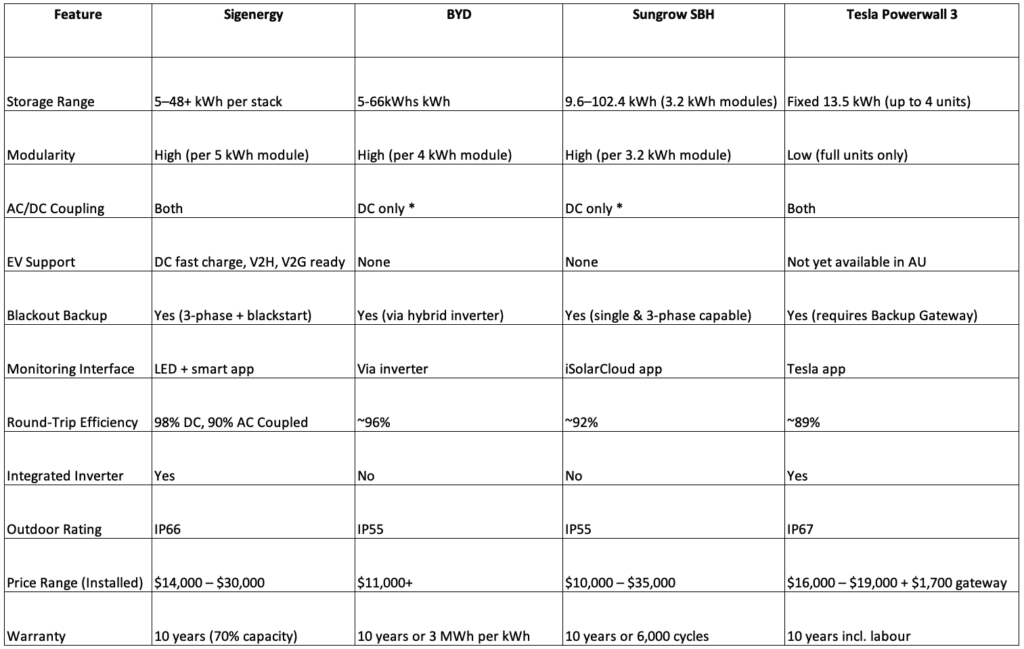
*Technically you can AC couple the BYD and Sungrow SBH battery but the only use case is if you are keeping the existing no-hybrid inverter with an existing solar system and using a hybrid inverter in addition to this. That way, you can AC couple it, but it means you are using two inverters which is not usually a cost effective or efficient design.
❓ Frequently Asked Questions (FAQ)
Q: Which battery is best for blackouts?
✅ Sigenergy, with instant switchover and blackstart ability, wins here. Tesla also supports backup but requires a separate Gateway.
Q: Can I expand these batteries later?
Yes — but Tesla requires full Powerwall additions. The others allow fine-tuned upgrades (3.2–5 kWh per module).
Q: Which battery is best if I own or plan to buy an EV?
✅ Sigenergy is the only option with EV fast charging and full V2H/V2G readiness in 2025.
Q: Are these batteries safe?
Yes. All four use LFP chemistry, which is more stable and safer than older cobalt-based batteries. Sigenergy adds another layer with AI thermal monitoring and integrated fire suppression.
Q: Will these batteries work with my existing solar?
It depends. Sigenergy and Tesla offer AC-coupled support, making them better for retrofits. BYD and Sungrow require compatible hybrid inverters, which are better suited to new installs.
Q: What happens if I use the battery a lot?
You’ll hit the throughput cap faster. For example, BYD warranties 2.525 MWh per kWh — meaning a 16 kWh system gets 40,000+ kWh of guaranteed usage.
The Verdict: Best Solar Battery in 2025
After analysing features, performance, warranties, safety, value, and real-world suitability for Australian homeowners, here’s how the top contenders stack up:
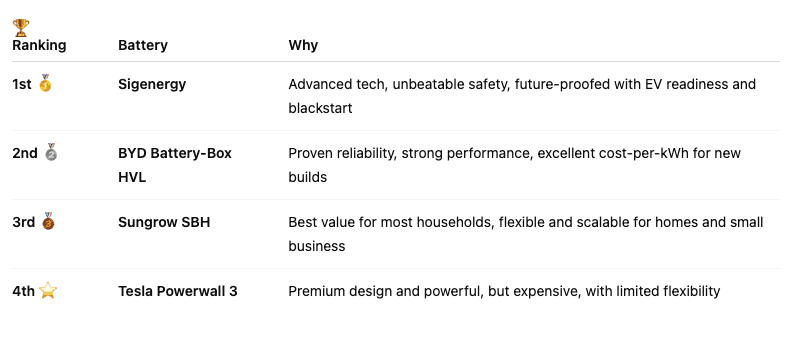
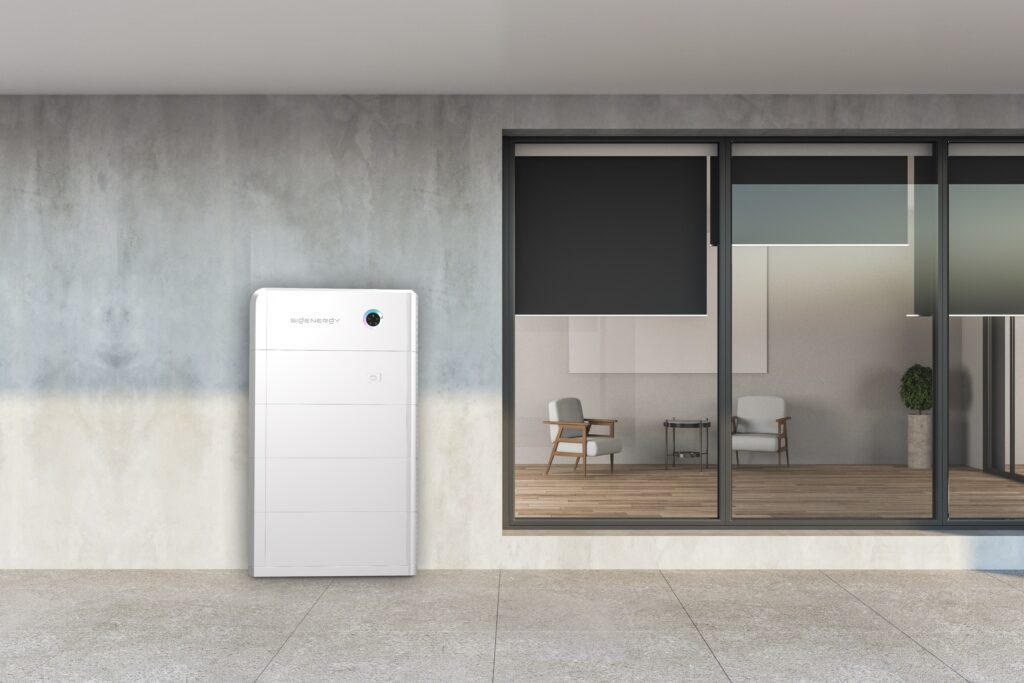
Final Thoughts on The Best Solar Battery In 2025
There’s no one-size-fits-all answer — it depends on your budget, energy needs, and goals. But if you want cutting-edge performance and full flexibility, Sigenergy is the clear winner in 2025.
At GI Energy, we don’t just install solar and batteries — we help homeowners make smarter energy choices, backed by reliable support, ethical practices, and more than a decade of experience in Australia.
Whether you’re looking to add a battery to an existing system, or starting fresh, we’ll help you find the right match.

